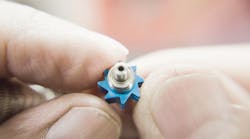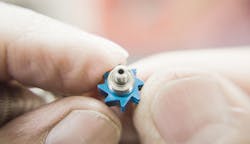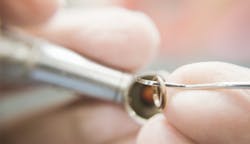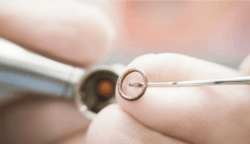Cheaper handpiece repairs aren’t always better—they’re actually worse
When you walk into your practice, you want things to run smoothly—no glitches, unexpected cancellations, staff conflicts, or equipment failures. Unfortunately, these things happen more often than we’d like because, to some extent, many are out of our control. That’s when we modify, adapt, and make the most out of the situation. But maybe we have more control than we think. Curious? Keep reading.
Steve Frost, DDS, who runs a successful endodontic office in Arizona, was looking to purchase new handpieces. He made the investment with KaVo and purchased the lubricating and maintenance accessories per the manufacturer’s recommendations, as it is well documented that daily handpiece maintenance is essential. The demand he put on his handpieces was high. Over time the torque, stress, and strain from cutting through zirconia, metal, and porcelain crowns took its toll.
After about a year and a half of heavy and intense use, as normal wear and tear would have it, the handpieces needed to be sent in for service and replacement parts. The fixes would be simple . . . or so he thought. He sent them out to a local repair provider and didn’t think anything of it when they came back.
However, after about five or six months, much to his dismay, he noticed the turbines grinding in several handpieces, which subsequently led to vibrating and overheating. Not good. He sent them back to the repair provider a second time, and the same thing happened. Only this time, he noticed that the color on the head was different (albeit slightly) than the rest of the handpiece, so he called his KaVo sales representative. Dr. Frost was slightly frustrated as his investment up to this point was costly and getting a little out of hand.
“Counterfeit parts,” the sales rep told him. Those two words summed it up. “Original equipment manufacturer, or OEM, parts comply with the highest standards and are manufactured to meet rigorous quality and regulatory requirements, whereas counterfeit parts may not be,” he explained. Unbeknownst to him, Dr. Frost’s handpiece was repaired with counterfeit parts. As a result, the turbines were more or less shot and the entire handpiece needed a complete overhaul. This was not the kind of news he wanted to hear, especially after he had already spent enough on repairs to have paid for a new handpiece.
If this story sounds familiar, there’s a good reason. I interviewed the repair managers of the top five dental handpiece repair companies that came up from a quick Google search. When asked about their service and parts protocol, four out of the five companies said that, unless the customer stated otherwise, after-market parts are used over OEM parts. Why? Because they’re cheaper.
Your first thought may be, “I don’t want to pay a big bill, and if the parts are just as good, then I don’t have a problem with it.” That’s part of the dilemma. We are made to believe they are just as good, but are they? You know the old saying, “If it’s too good to be true, it probably is”? In the case of handpiece repair, it really is.
Handpieces are one of the most heavily used pieces of equipment in a dental office, yet most practices don’t have contingency plans for repairs. Or if a repaired handpiece breaks, dentists often default to thinking the issue is with the handpiece, instead of the inferior parts used in an earlier repair.
To get better insight into why counterfeit parts are such a problem, I talked with Nichole Hansen who is the manager of the handpiece repair department at KaVo. The first thing she told me is that repairs arrive at her facility daily because they were fixed without OEM parts. It gets even more interesting:
- Counterfeit parts can significantly increase the risk of damaging genuine internal parts—yes, the parts may “fit,” but that doesn’t mean they will last or maximize the anticipated lifetime use of the handpiece.
- Handpieces that come in with counterfeit parts will typically last less than six months The most common complaints include gear grinding, loud noises, inadequate or inefficient cutting, and overheating.
- While cheaper repairs are initially more appealing, dentists might end up spending two to three times more using generic parts than they would if they had repaired it properly with OEM parts in the first place.
- This one is worth repeating: OEM parts comply with the highest standards and are manufactured to meet rigorous quality and regulatory requirements. Counterfeit parts may not be.
- With counterfeit parts, the likelihood of the handpiece malfunctioning increases, which raises extreme safety concerns for your patients.
- Not all after-market parts are considered counterfeit, but KaVo always recommends using only genuine parts to ensure the maximum performance and lifespan of the handpiece.
- Both after-market and counterfeit parts could potentially void any manufacturer warranties on the handpiece.
- When repaired at an authorized facility by a certified technician, notes, test outcomes, and the technician ID will accompany the return.
Here you can see corrosion beginning to form on this counterfeit O-ring.
We always look for ways to save money and be more efficient with what we do. That’s prudent and good business sense. So let me ask you this: Do you want to spend your money twice when it comes to your equipment?
Let’s put this into perspective. A patient comes in with a broken tooth needing a crown. The patient wants a cheap fix, and you say the best investment is a crown because it returns the tooth to full form and function. A large filling, on the other hand, is a temporary fix, and the patient can ultimately lose the tooth. The key question is this: Is it worth it in the long run to save a few bucks now, in exchange for increasing the risk of losing a tooth? I don’t know about you, but I’d get the crown done. The same goes with our handpieces. Don’t take a risk because it’s cheaper. Insist on getting the best parts for a maximized return on your investment.
Greg Gillespie, DDS, a general dentist in Washington state, has had his own share of negative experiences with faulty parts and nonauthorized repairs. He now insists on only OEM parts and recommends the following:
- Use only repair providers who have been authorized by your device’s manufacturer.
- Look for a guarantee. Many unauthorized repair providers do not guarantee that their repair will last.
- Insist on only OEM parts. For example, KaVo uses OEM parts 100% of the time for all repairs, which allows them to return the handpiece back to its original performance.
- Choose a repair provider who offers knowledgeable customer service to provide full support and answer questions about your instrument.
- Ask for a report on your handpiece repair. Most authorized repair teams perform tests on handpieces with every repair. They include the test results and detailed notes with each repair, giving you invaluable information for the life of your handpiece.
Mishaps will happen within every practice. While many are out of your control, handpiece repair isn’t. The next time your handpiece starts to grind or overheat, make the wise decision to get it fixed correctly. Although the less expensive alternative may be enticing, you should insist on an authorized repair facility that only uses OEM parts. This will save you time and money as you properly maintain one of the most important tools in your practice. Dentistry is your livelihood, and this is definitely worth the investment.
Disclosure: Dr. Simmons received an honorarium from KaVo for the authorship of this article. All information and recommendations are consistent with Dr. Simmons's normal course of clinical practice.
Stacey L. Simmons, DDS, a graduate of Marquette University School of Dentistry, is in private practice in Hamilton, Montana. She is a guest lecturer at the University of Montana in the Anatomy and Physiology department. Dr. Simmons is the editorial director of Breakthrough Clinical and a contributing author for DentistryIQ, Perio-Implant Advisory, and Dental Economics. She also serves on the Dental Economics editorial advisory board. You may contact her at [email protected].










